Features
Donald Trump and the 2024 Jewish Vote

By HENRY SREBRNIK How did American Jews vote in the November 5, 2024 presidential election? There’s no simple answer. American Jews are a hard-to-define religious and ethnic group spread across multiple American Census categories, possessing last names from at least a dozen different languages and clustered in places that are often overwhelmingly non-Jewish. It takes a team of demographers and sociologists to determine a plausible American Jewish population figure.
So deciding who qualifies as a Jewish voter is not that easy. Must they feel a sense of belonging to the Jewish people, however defined? Or can they be “simply” Jewish, perhaps with a non-Jewish partner and children not being brought up as Jews? (After all, we have Jews by birth who are “anti-Zionists” and supporters of Palestinian efforts to destroy Israel.) That’s why figures vary widely.
American Jews number less than 2.5 per cent of the total U.S. population. To be sure, Jews vote in much greater percentages (approximately 80 per cent) than the rest of the American public (about 66 per cent). But the Jewish role in American politics goes well beyond the ballot box. In 2016, the Jerusalem Post reported on a study showing that Jews donate 50 per cent of all funding to the Democratic Party and 25 percent of all funding to the Republican Party. For the 2024 election, Forbes revealed that the top 15 donors to the Kamala Harris campaign were all people who identified as Jewish.
For about a century, American Jews, however defined, have been a reliable piece of the Democratic Party base, usually delivering two-thirds or more of their votes to the party’s presidential nominee. Over the last half century, going back to the 1968 election, Jews have favored the Democratic candidate by about 71 to 29 per cent. But in 2024, change was in the air, despite the absurd claims by some people that Donald Trump was an “antisemite.”
It turns out this proved largely baseless, according to the “2024 Jewish Vote Analysis,” a report released on November 20, 2024 by WPA Intelligence, a conservative political consultancy and analytics firm. In examining available exit polling, city and county data, and precinct data, it suggested that Trump’s strongest gains were among “those who live the most Jewish lives and reside in the most Jewish communities.”
Looking at Jewish neighbourhoods and towns, “the trends are stark and unmistakable,” WPA Intelligence stated. “Because Judaism is in some ways a communal religion and observant Judaism requires localized infrastructure, Jews who live in Jewish areas tend to be more religious and engaged. And in these neighborhoods, we see large shifts towards Trump.” Some of the most dramatic swings in the Jewish vote happened in New York. It also identified shifts in heavily Jewish areas of California, Florida, Michigan, New Jersey,and Pennsylvania. (California, New Jersey, and New York are where more than 45 per cent of American Jews live.)
“The trend is apparent from Trump’s near-unanimous support among Chassidic and Yeshivish Jews; to his rapid consolidation of the Modern Orthodox vote; to incremental gains even in more liberal Jewish areas such as Oak Park and Upper Manhattan,” the report added. “So, too, is it diverse ethnically and geographically, occurring coast to coast and overrepresenting Persian and ex-Soviet Jewish communities.”
Trump received the “overwhelming” majority of votes in New York City precincts with a Jewish population of at least 25 per cent. His 2024 performance in New York marked a substantial improvement over the 2020 and 2016 elections.
Trump also enjoyed greater success in heavily Jewish enclaves of deep-blue Democratic cities such as Chicago and Los Angeles, according to data compiled by the Chicago Board of Election Commissioners and the Los Angeles Times, respectively.
These gains have been confirmed by the Jewish website Tablet. “Who Won the Jewish Vote?” by Armin Rosen, published on November 14, 2024, includes very detailed comparisons of precinct-level numbers from the 2020 and 2024 elections. It indicated that Trump did improve his performance in a range of Jewish neighborhoods across America. “From the yeshivas of Lakewood, New Jersey, to the bagel shops of New York’s Upper West Side; from Persian Los Angeles to Venezuelan Miami; from the Detroit suburbs to the Chabadnik shchuna in Brooklyn’s Crown Heights, Jewish areas voted in higher percentages for the Republican candidate than they did in 2020.”
Nearly every neighborhood in New York with a notable density of Jewish-specific businesses and institutions, be they Hasidic, Litvish, Syrian, Russian, Bukharan, Conservative, Reform or modern Orthodox, voted heavily Republican or saw a rise in Trump’s performance.
In Brooklyn, the Midwood precincts containing Yeshiva of Flatbush voted 62 per cent for Trump. In Brighton Beach, Brooklyn’s main post-Soviet Jewish enclave, Trump’s support was consistently in the 75-90 per cent range. In Crown Heights, headquarters of the Chabad Hasidic movement, Trump got 62 per cent of the vote this time around, likely on the strength of higher turnout among Chabadniks. Back in 2016, when Trump ran against Hillary Clinton, he won 69 per cent of the vote in all of Assembly District 48, which encompasses Borough Park and Midwood (both largely Jewish communities). This year, he won 85 per cent of the vote in the district.
In the Bronx, Trump received 30 per cent of the vote in the precinct containing the Riverdale Jewish Center, and 38 per cent in the precinct with the neighborhood’s Chabad house. In Manhattan, a few of the borough’s lightest-blue Democratic precincts have the Yeshiva University campus at their center, and Trump managed to receive 37 per cent of the vote there. The Upper West Side, a traditional liberal Jewish political and cultural bastion, remained dark blue. But even there it was possible to see a shift.
Ranging a bit further afield, at least one plausible study, a poll taken by the Teach Coalition, an advocacy group founded by the Jewish Orthodox Union, found overall Jewish support for Trump in the New York suburbs at 40 per cent. Nassau County, where Jews make up close to 20 per cent of the population, saw Trump win it by five per cent, while Joe Biden took it by 10 in 2020.
The returns from other major American Jewish population centers tell a similar story, according to Tablet. Over 600,000 Jews live in New Jersey. The modern Orthodox stronghold of Teaneck gave Trump 35 per cent. In fact, he won 70 per cent of the vote in districts where most of the town’s synagogues are located. In Lakewood, where nearly every strain of Orthodox Judaism is represented, “Some of the precinct results are eye-watering,” reports Tablet. There, Kamala Harris got just 11.2 per cent. In one Lakewood precinct, District 27, Trump won all the votes, 366–0, and in another, District 36, he won 560 votes, losing only a single vote.
Trump carried Passaic County, home to a sizable Orthodox Jewish constituency. Jews make up about 25 percent of the county’s population and it has been a Democratic stronghold for decades. Biden took it with 57.5 per cent to Trump’s 41 per cent four years ago. In 2024, Trump won it with 50 per cent to Harris’s 46.5 percent. That’s a 16-point overall swing in Trump’s favor.
Voting data indicates that there was a significant shift among Jewish voters in in the crucial state of Pennsylvania. It was one of the few states without a large Orthodox Jewish population where Trump did especially well with Jewish voters. Harris did win Pennsylvania Jewish voters by seven percentage points, 48-41, according to a survey conducted by the Honan Strategy Group for the Teach Coalition. However, 53 per cent of Jewish voters said they would have pulled the lever for her had Pennsylvania governor Josh Shapiro been her running mate, while support for Trump would have dropped to 38 per cent. Jewish community leaders claimed that Shapiro was subjected to an ugly, antisemitic campaign that led to him being passed over for the slot.
The Miami area is home to over 500,000 Jews. Aventura is one of the community’s bellwethers, and Trump gained 59.7 per cent this year. An almost identical shift happened in the Miami Beach community of Surfside, where Trump took 61 per cent. Bal Harbour, another Jewish enclave, saw Trump gain 72 per cent.
In Palm Beach County, there are about 175,000 Jews out of a population of 1.5 million, or about 12 per cent. Harris won this county by 0.74 per cent, while Biden won it by 13 per cent in 2020. Trump’s vote climbed nearly seven per cent while hers dropped an equal amount off Biden’s number. Almost exactly the same type of shift happened in Broward County, where Biden got 64 per cent in 2020; the vote shifted 14 per cent toward Trump this year. Jews make up about 10 per cent of the Broward population.
In Los Angeles, where 560,000 Jews live, an article by Louis Keene, “How a Jewish Neighbourhood in Liberal Los Angeles Became a Stronghold for Trump,” published December 10 in the Forward newspaper, provides a detailed picture of the Jewish electorate. The political shift in Pico-Robertson, an Orthodox neighborhood in LA’s Westside, reflects voters “with a change of heart and changing demographics.”
Formerly majority Democratic, in 2024 for the first time, parts of Pico-Robertson turned red. Its two largest precincts swung for Trump, who received about 51 per cent of the votes compared to 44 per cent for Harris. Rabbi Elazar Muskin, who leads Young Israel of Century City, one of the oldest and largest synagogues in the neighbourhood, estimated that up to 90 per cent of his congregation voted for Trump, largely because of Israel.
As Yeshivish and Mizrahi Jews — those of Middle Eastern or North African heritage — have established a greater presence in Pico-Robertson, the area has become increasingly defined by a conservative culture and electorate. There is also a booming Persian population, as well as emergent Chabad and other Hasidic Jews.
A poll of Orthodox voters by Nishma Research in September found 93 per cent of Haredi voters supporting Trump; while data on the Persian Jewish community’s politics is harder to come by, community leaders said the numbers are similar.
Elsewhere in LA, the presence of a Chabad house or a synagogue was a reliable predictor of Trump support. For instance, Trump got 40 per cent of the vote in the North Hollywood precinct where Adat Yeshurun Valley Sephardic and Em Habanim Sephardic are located.
Los Angeles in turn mirrors the general trend in the rest of the country. Michigan is home to 116,000 Jews. West Bloomfield, centre of the Detroit-area Jewish community, went 43.7 per cent for Trump. Illinois’ 319,000 Jews live mainly in Chicago. Trump picked up votes in the Far North Side wards where Orthodox Jewish voters live, especially in the 50th Ward, where his vote increased to 46.85 per cent from 33.77 per cent in 2020.
Of course the Republican vote did not just come from the very religious. Trump also clearly gained among those most committed to Jewish identity, regardless of affiliation or observance, who were driven by concerns over left-wing antisemitism after the October 7 massacre.
Over the course of his campaign, Trump repeatedly touted his support for the Jewish state during his first term in office. While courting Jewish voters, Trump reminded Jews about his administration’s work in fostering the Abraham Accords, promising to resume the efforts to strengthen them. Trump also recognized Israel’s sovereignty over the Golan Heights, a strategic region on Israel’s northern border previously controlled by Syria, and he also moved the U.S. embassy in Israel to Jerusalem, recognizing the city as the Jewish state’s capital.
We must lay to rest the nonsense about Trump being antisemitic, lest we are to believe that the more Jewish you are, the more likely it was that you voted for an enemy of the Jewish people. Americans, including Jews, returned the arguably most pro-Israel president since the founding of the modern Jewish state to the White House.
Henry Srebrnik is a professor of political science at the University of Prince Edward Island.
Features
Japanese Straightening/Hair Rebonding at SETS on Corydon
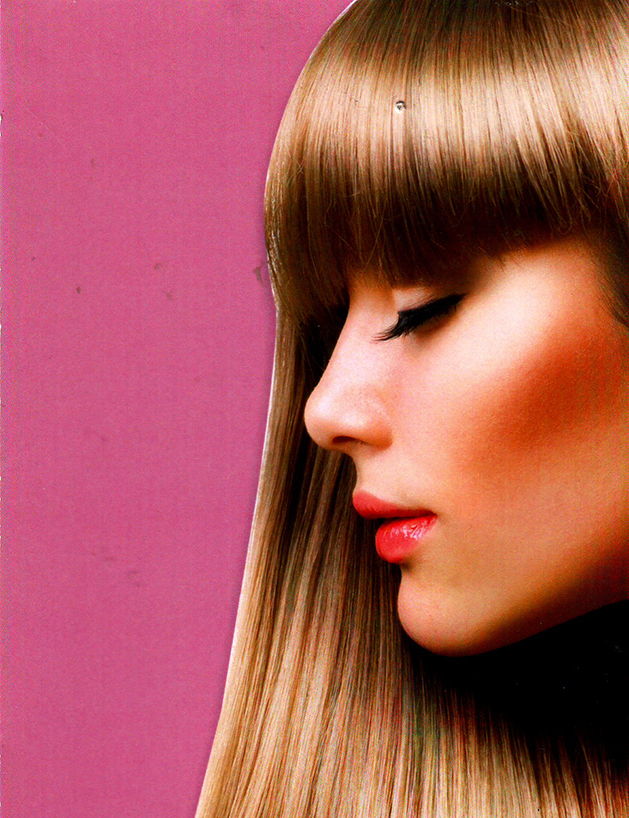
Japanese Straightening is a hair straightening process invented in Japan that has swept America.

Features
History of the Winnipeg Beach Synagogue: 1950-2025
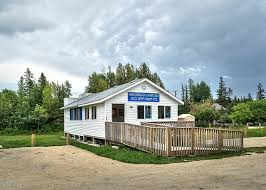
By BERNIE BELLAN The history of the Winnipeg Beach Synagogue is a fascinating one. We have had several articles over the years about the synagogue in The Jewish Post & News.
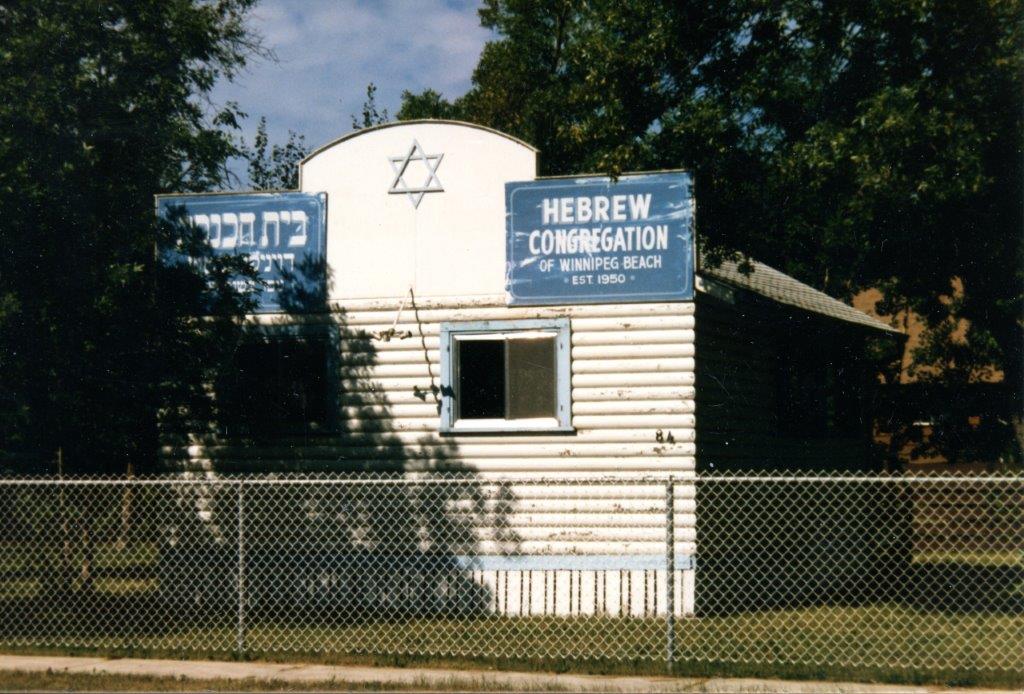
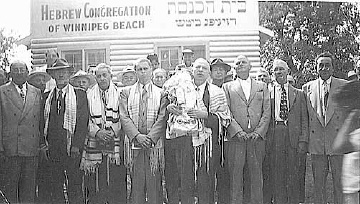
In June 2010 I wrote an article for The Jewish Post & News upon the 60th anniversary of the synagogue’s opening. Here are the opening paragraphs from that article:
“Sixty years ago a group of Winnipeg Beach vacationers decided that what their vacation area lacked was a synagogue. As it happened, a log cabin one-room schoolhouse in the Beausejour area happened to be available.
“In due course, the log cabin was relocated to the corner of Hazel and Grove in Winnipeg Beach, where it stayed for 48 years.”
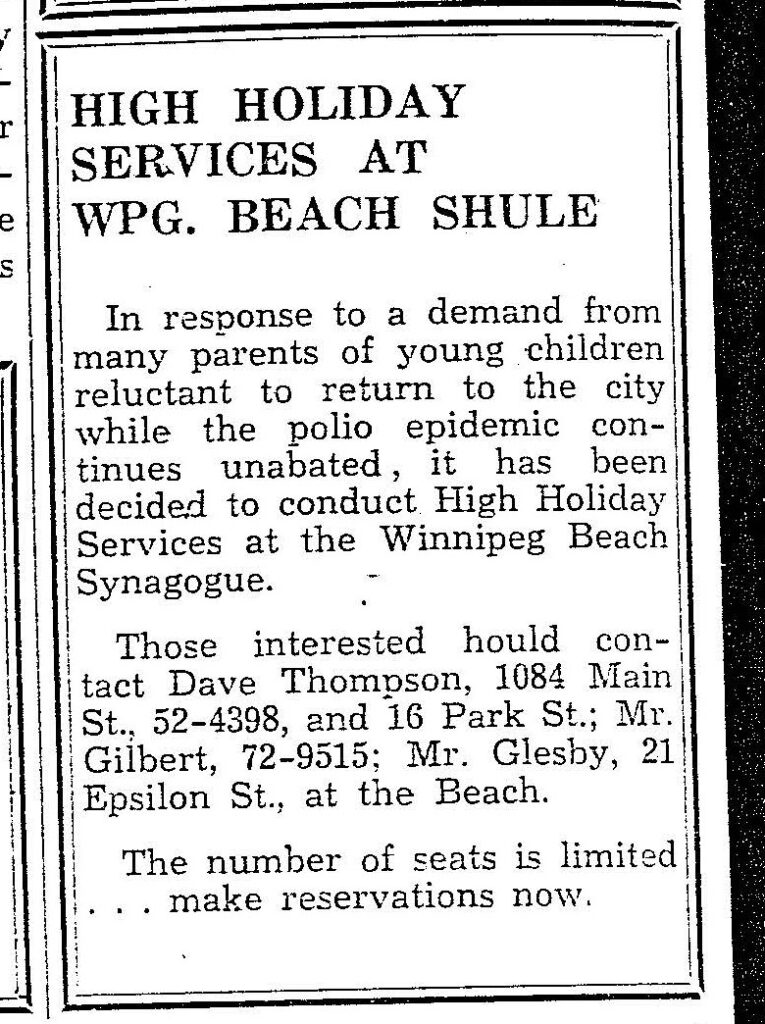
In December 1994 my late brother, Matt, wrote a story about the spraying of antisemitic grafitti on the synagogue which, at that time, was still situated at its original location on the corner of Hazel and Grove in the town of Winnipeg Beach:
“Two 16-year-olds spraypainted slogans like ‘Die Jews,’ ‘I’ll kill you Jews,’ and other grafitti in big letters on the beach synagogue.
“Jim Mosher, a news reporter for the Interlake Spectator in Gimli, said last Halloween’s vandalism against the synagogue wasn’t the first. In the late 1980s, he claimed, it was spraypainted with swastikas.
“Jack Markson, a longtime member of the Winnipeg Beach Synagogue, last week also said he could remember finding anti-Semitic grafitti spraypainted on the synagogue ‘a few years ago,’ and at least twice in the 1970s, when the cottage season was over.”
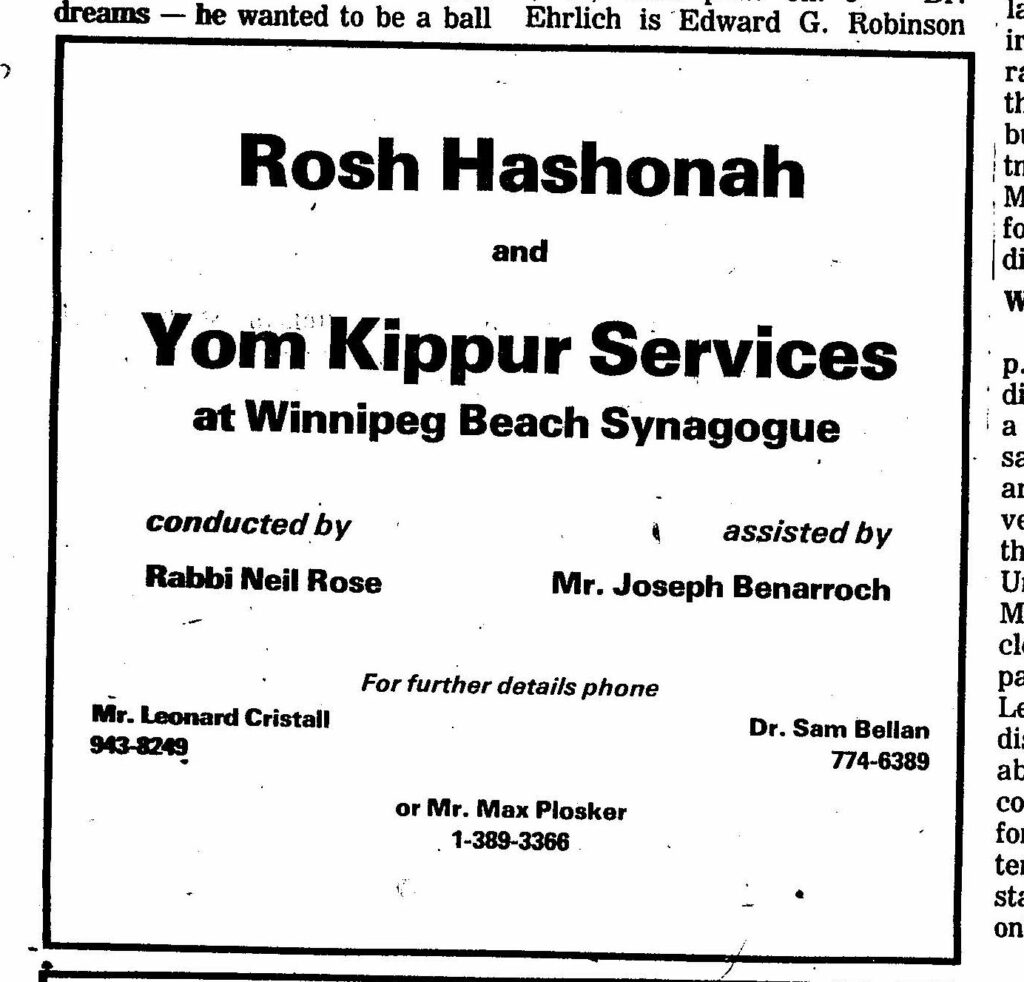
My 2010 article continued: “In 1998 the Town of Winnipeg Beach informed the members of the synagogue that the building would have to be hooked up to the town’s sewer and water system. Rather than incur the cost of $3-4,000, which was thought to be ‘prohibitive,’ according to longtime beach synagogue attendee Laurie Mainster, synagogue goers looked elsewhere for a solution.
“As a result, the board of Camp Massad was approached and asked whether the synagogue might be relocated there, with the understanding that the synagogue would be made available to the camp at any time other than what were then Friday evening and Saturday morning services.
“Over the years the ‘beach synagogue’ had come to be a very popular meeting place for summertime residents of Winnipeg Beach and Gimli. In fact, for years minyans were held twice daily, in addition to regular Saturday morning services. Of course, in those years Winnipeg Beach was also home to a kosher butcher shop.
“While the little synagogue, which measured only 18 x 24 feet, has gone through several transformations, including the move to Camp Massad, and the opening up to egalitarian services in 2007 (The move to egalitarian services was as much a practical necessity as it was a nod to the equality of women – the only Kohen present at the time was a woman!), it has always remained cramped at the best of times.
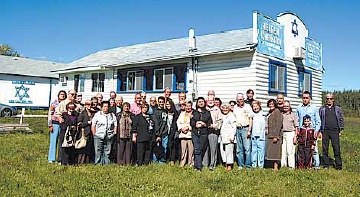
“In recent years the synagogue has seen the addition of a window airconditioner (although to benefit from it, you really have to be sitting just a few feet away), as well as a fridge that allows synagogue attendees to enjoy a regular Saturday morning Kiddush meal following the service.
“According to Laurie Mainster, the Saturday morning service has continued to be popular, even though many of the attendees now drive in from Winnipeg, as they have sold the cottages they once maintained.
“On the other hand, one of the side benefits to being located on Camp Massad’s grounds has been an infusion of young blood from among the camp counsellors.
“Since there is no longer a rabbi available to conduct services (Rabbi Weizman did lead services for years while he had a cottage at the beach), those in attendance now take turns leading the services themselves.
“Anyone may attend services and, while there are no dues collected, donations are welcome. (Donations should be made to the Jewish Foundation of Manitoba, with donors asked to specify that their donations are to be directed to the beach synagogue.)
“Mainster also says that the beach synagogue is now undergoing an expansion, which will be its first in 60 years. An entirely new space measuring 16 x 18 feet is being added – one that will allow for a real Kiddush area. (Until now, a table has been set up in the back of the synagogue and synagogue goers would help themselves to the buffet that is set up each Saturday during the summer. While pleasant enough, it will certainly be more comfortable to have an actual area set aside for the Saturday afternoon after service lunch.)
“As for dress, longtime attendee Abe Borzykowski (in an article written by Sharon Chisvin for the Free Press in 2007) remarked that ‘I don’t think there are many synagogues where people can attend in shorts, T-shirts and sandals and not feel out of place.’ “
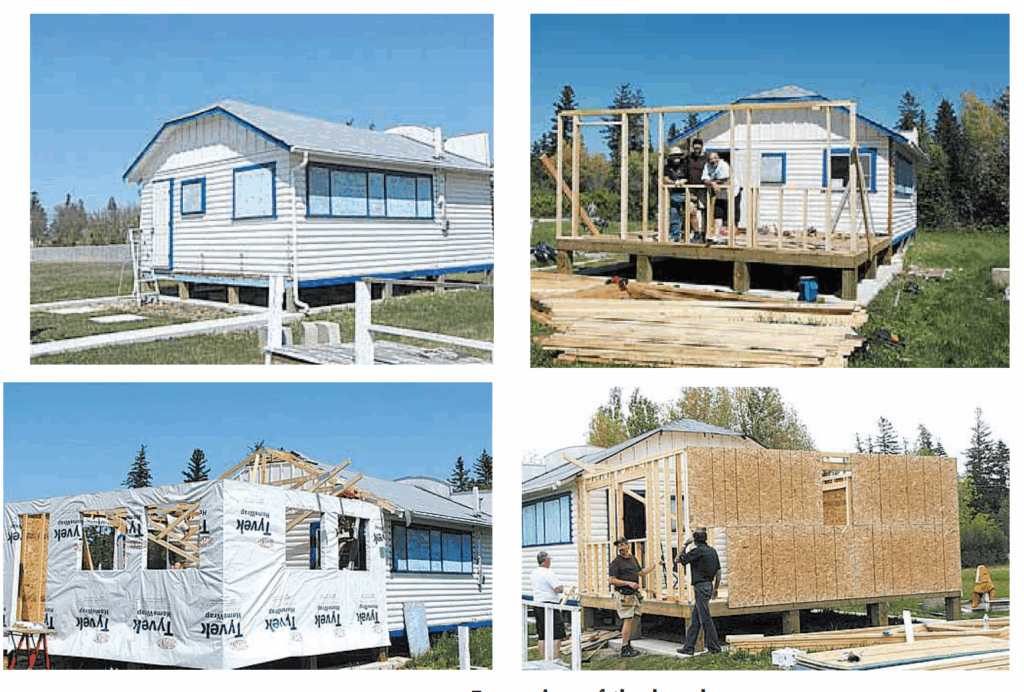
As mentioned in that 2010 article, the beach synagogue at that time was about to undergo an extensive remodelling. Here is an article from a January 2011 issue that describes that remodelling process. The article was written by Bernie Sucharov, who has been a longtime member of the beach synagogue:
“The Hebrew Congregation of Winnipeg Beach made a major change to the synagogue this past summer. With the help of many volunteers, Joel Margolese being the project manager, the synagogue was expanded and an addition was built to handle the overflow crowds, as well as to add more space for the kiddush following services.
“The volunteers spent many Sundays during the summer months building the addition. Bad weather caused many delays, but finally the addition was completed one week before the official summer opening.
“The volunteers were: Joel Margolese, Gordon Steindel, Sheldon Koslovsky, Viktor Lewin, Harvey Zabenskie, Nestor Wowryk, Kevin Wowryk, Victor Spigelman, Jerry Pritchard, and David Bloomfield.
“On Sunday, June 25, 2010 a special ceremony was held to affix a mezzuzah to the front entrance door. Gordon Steindel had the honour of affixing the mezzuzah, which was donated by Sid Bercovich and Clarice Silver.
“Refreshments and food for the day were prepared by Phyllis Spigelman, also known as our catering manager. Throughout the summer, Phyllis, Lenore Kagan and other friends prepared the food for our kiddush.
“A sound system was donated by Arch and Brenda Honigman in memory of their father, Sam Honigman z”l. “The system was installed by Joel Margolese and Stevan Sucharov. This will allow the overflow crowd to hear the service in the new addition.
“There were also generous donations of 50 chumashim and an air conditioner. The chumashim were donated by Gwen, Sheldon and Mark Koslovsky. The air conditioner in the new addition was donated by Joel and Linda Margolese.
“The official opening of the synagogue for the summer took place on July 3, 2010. We had an overflow crowd of 70+ people.”
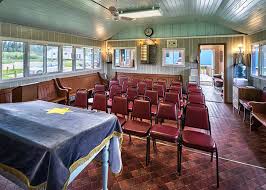
Since that 2010 major addition to the synagogue, it has also added a wheelchair ramp (although I’ve been unable to ascertain exactly when the ramp was built). Also, the synagogue also has its own outdoor privy now. (Attendees used to have to use facilities in Camp Massad.)
And, as already noted in article previously posted to this site (and which you can read at Beach Synagogue about to celebrate 75th anniversary), in recognition of that occasion, on August 2nd members of the synagogue will be holding a 75th anniversary celebration.
As part of the celebration anyone who is a descendant or relative of any of the original members of the first executive committee is invited to attend the synagogue that morning.
If you are a relative please contact Abe Borzykowski at wpgbeachshule@shaw.ca or aborzykowski@shaw.ca to let Abe know you might be attending.
Features
Kinzey Posen: CBC Winnipeg’s former “go-to guy”

By GERRY POSNER If former Winnipegger Lawrence Wall was the CBC go-to guy in Ottawa, CBC Winnipeg had its own version of a go-to guy for many years with none other than the very well known Kinzey Posen. Of course, many readers will recognize that name from his career with Finjan, the Klezmer group so famous across Canada and beyond. It has been written about Posen and his wife Shayla Fink that they have been involved in music since they got out of diapers. And, as an aside, their love and ability in music has now been transmitted to the next generation as in their son, Ariel Posen (but that’s another story).
Kinzey Posen (not to be confused with Posner, or maybe we are to be confused, but who knows for sure?), was a graduate of Peretz School, having attended there from nursery right until Grade 7, graduating in1966. That was followed by Edmund Partridge and West Kildonan Collegiate. Musically, he was in large part self taught. However, he did have some teachers along the way. After moving to Vancouver – from 1974-78, he had the chance to study acoustic classical bass with a member of the Vancouver Symphony Orchestra. When Kinzey lived in Vancouver, he also worked as a jazz musician.
Upon returning to Winnipeg, Kinzey enrolled as a mature student at the University of Winnipeg, where he obtained a Bachelor of Urban Studies degree. Although the degree was in no way connected to the career that followed, his attending the University of Winnipeg was critical to his connecting with the CBC. Why? you ask. Kinzey had a position after graduation working for the Institute of Urban Studies. While there, he met someone who invited him to work for the Department of Continuing Education as one of their program directors. At the time the Department of Continuing Education was located at 491 Portage Avenue, which was also known as the TJ Rice Building. The CBC also leased some space in the same building. According to Kinzey, the CBC part of the building “included HR, different shows and other support offices. Continuing Education was located in the basement and main floor and that’s where I worked.”
KInzey had long had an interest in the CBC, which made the fact that the CBC had some offices in the same building where he was working serendipitous. That Kinzey might be interested in visiting the CBC was not an accident. As a young boy he had a nightly connection to CBC, as it was his ritual to listen to CBC Radio (as well as all sorts of other radio stations across the USA) on his transistor radio every night in bed. He became enamoured of one particular CBC host, Bill Guest, so that when going to sleep, he imagined that he was Guest doing interviews with imaginary guests. That dream of working for CBC became a reality when he had a chance to do a one week gig with Jack Farr’s network program.
Kinzey took a week off from his Continuing Education job and spent five days at the CBC. That week was a training session for Posen, as he had to create ideas, research, pre-interview, write the script, and set up the studio for Farr’s interview. He was almost in his dream job – although not quite – since it was only for one week. His opportunity, however, came in 1988, when he was offered a one-year term as a production assistant – the lowest guy on the ladder, for a show called “ Simply Folk,” with the late Mitch Podolak as the host. Although he was indeed at the bottom as far as those working on the show were concerned, he took a chance and gave his notice to the U of W. The rest is history. In his new job, Kinzey learned how to become a producer. Lucky for him, at the end of the year, when the person he replaced was supposed to come back, she never returned (just like the song, “MTA,” by the Kingston Trio). At that point, Kinzey was hired full time at the CBC.
Kinzey was a fixture at the CBC for 27 years. During those years, Kinzey had the chance to work with Ross Porter, a respected former CBC host and producer, also with Karen Sanders – on the “Afternoon Edition.” One aspect of Kinzey’s job on the Afternoon Edition was to come up with ideas, mix sound effects, arrange interviews and music, to create a two-hour radio experience. In addition, he covered jazz and folk festivals and, as a result, was exposed to some of the best musicians in the world. With Ross Porter in the 1990s, he worked on a network jazz show called “ After Hours,” which was on from 8-10 PM five nights a week. Kinzey was involved with writing the scripts, picking the music, and recording the shows, as well as editing them and then presenting them to the network for playback.
Of course, over his career, Kinzey had many memorable moments. He told me about one of them. The story revolved around the National Jazz Awards one year in particular. The awards were to be broadcasted after the National News which, in those days, began much earlier in the evening, and were over by 8:00 pm. The legendary Oscar Peterson was lined up to play a half hour set at the awards, starting at 7:30. But, as Kinzey told me, Oscar Peterson had a “hate on” for the CBC ecause one of his recorded performances was wrongly edited and he refused to appear on CBC under any circumstances. As the time neared 8:05 PM, which was when the CBC was to begin its broadcast of the jazz awards, it became apparent that Oscar was not going to finish on time. As the producer of the awards show, Kinzey was tasked with telling Oscar Peterson to wrap it up and get off the stage. There was Kinzey Posen, a huge fan of Oscar Peterson, now faced with the prospect of telling Oscar – while he was still playing – with 500 people in the audience, to stop and get off the stage. Not often was or is Kinzey Posen frozen, but that was one such moment. There was one loud “Baruch Hashem” from Kinzey when Oscar completed his set literally just in time.
Clearly, Kinzey was part of a very successful run with After Hours as it was on the air for 14 years. It was easily one of the most popular shows on CBC Radio 2, and a winner of several broadcasting awards. Kinzey also played a major role in producing a two part documentary about legendary guitarist Lenny Breau.
When After Hours ended, Posen became one of the contributing producers to Canada Live and specialized in producing live radio specials for the network, such as the Junos, for CBC Radio One and Two. Needless to say, his career planted Posen in the world of some top notch musicians, including his time spent working with Robert Plant (Led Zeppelin), Dave Brubeck, Randy Bachman, Chantal Kreviazuk and a list of prominent names in the Canadian, American and European music spheres. Locally, the CBC came to refer to Kinzey as the Jewish expert. I would add music expert to that title.
After his 27 year run at the CBC – and before he fully retired, Kinzey went on to work for the Rady JCC as a program director for a year and a half. Of course, to say that Kinzey Posen is retired is a major contradiction in terms. You really can’t keep him down and he has his hand in a variety of programs and projects – most of which he remains silent about, as is his style.
When I realized the full depth and talent of Kinzey Posen, I quickly concluded that he must certainly be related to me. Even if he isn’t, I now tell people he is.
